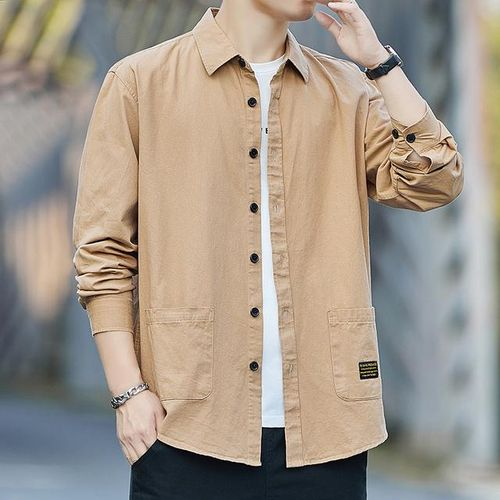Have you ever wondered why the buttons on men’s and women’s shirts are placed on opposite sides? It’s one of those things we rarely question but simply accept as part of fashion. This quirky difference isn’t just a random design choice—it’s deeply rooted in centuries of cultural, social, and practical factors. To understand why men’s shirts have buttons on the right and women’s on the left, we need to journey back to the 13th century when buttons first appeared and see how tradition continues to shape fashion today.
The Origins of Buttons: A Symbol of Wealth and Class

Buttons were invented in the 13th century, but they weren’t always the common, affordable fasteners we know today. In fact, buttons were incredibly expensive and were primarily used by the upper class. These buttons weren’t made of plastic or metal, but of luxurious materials like gold, silver, pearls, gemstones, and ivory. As a result, only wealthy women could afford to wear clothes adorned with buttons, and these garments were a reflection of their social status.
At this time, common women used simpler fasteners such as fabric ties or wooden clasps, reserving the use of buttons for the rich. The placement of buttons on the left side for women’s clothing and on the right for men wasn’t arbitrary—it was a reflection of social hierarchy and practicality. This early distinction set the foundation for the fashion traditions we still follow today.
Women Didn’t Dress Themselves: A Key to Button Placement
One of the most compelling reasons behind the placement of buttons on women’s clothing stems from the fact that, during the 13th century, wealthy women didn’t dress themselves. They had maids or servants to help them, and because most people were right-handed, it was more practical for the buttons to be placed on the left side of the garment. This made it easier for the maid, who stood facing the woman, to fasten the buttons.
This small detail became a subtle but significant indicator of wealth. If a woman wore a dress with buttons on the left, it was a sign that she belonged to an affluent household, one that could afford a servant to help her dress. The positioning of buttons was not only about convenience but also a statement of class and status.
Men’s Button Placement: A Nod to Military History
For men, the placement of buttons on the right side has a different historical origin—one rooted in practicality and military traditions. Most men are right-handed, and throughout history, men were often required to carry weapons as part of their daily lives. Whether for hunting or combat, men needed easy access to their weapons, which were typically carried on the left side of their bodies for quick, right-handed drawing.
By placing buttons on the right side of men’s clothing, it allowed for faster, smoother access to weapons concealed within the clothing. This design choice, driven by necessity, became a standard feature of men’s fashion. Even as times changed and the need to carry weapons diminished, the tradition of right-side buttons stuck, a lasting influence from centuries of military customs.
Class Distinctions in Fashion: Haute Couture vs. Everyday Wear

As buttoned clothing became more widespread, the distinctions between the rich and the poor continued to play a role in fashion. While the wealthy enjoyed garments fastened with intricate buttons, everyday people still relied on more straightforward methods of securing their clothing. The divide between haute couture (high fashion) and everyday wear grew deeper as buttons remained a status symbol for the elite.
This is why, even today, women’s clothing often maintains its left-side button placement—a lingering tradition from the days when the wealthy were dressed by others, and the right-handed maids needed buttons on the left for convenience.
Modern Fashion and the Evolution of Buttons
Fast forward to the present, and while society has evolved significantly, the button placement on men’s and women’s shirts hasn’t changed. For men, buttons are still on the right, a holdover from centuries of military influence. For women, buttons remain on the left, a nod to the days when dressing was a luxury afforded to the wealthy.
Even though the practical reasons for button placement no longer apply in the same way, the tradition has become ingrained in modern fashion. Button placement is one of those quirks of style that connects us to the past, a reminder of the social and historical forces that have shaped the way we dress today.
Is There a Practical Need for Different Button Placements Today?

While the original reasons for button placement—wealth, servants, and weapon access—no longer hold the same weight, the tradition persists. Modern fashion doesn’t require men and women to have buttons on different sides for any practical reason. In fact, many people don’t even notice the difference unless it’s pointed out.
However, fashion is often as much about tradition and style as it is about practicality. The continued use of this design detail reflects both the stability of fashion norms and our desire to maintain a connection to history. In an era where trends come and go, the simple placement of buttons remains a timeless feature of clothing design.
Conclusion: The Legacy of Button Placement in Modern Fashion
The placement of buttons on men’s and women’s shirts may seem like a minor detail, but it’s a fascinating example of how history and culture influence fashion. From the 13th century origins of buttons as a luxury for the wealthy to the military practicality of right-side button placement for men, this small design element tells a story of class, gender roles, and tradition. Today, while the reasons behind button placement may no longer be relevant, the tradition continues, a subtle reminder of fashion’s deep roots in history.


